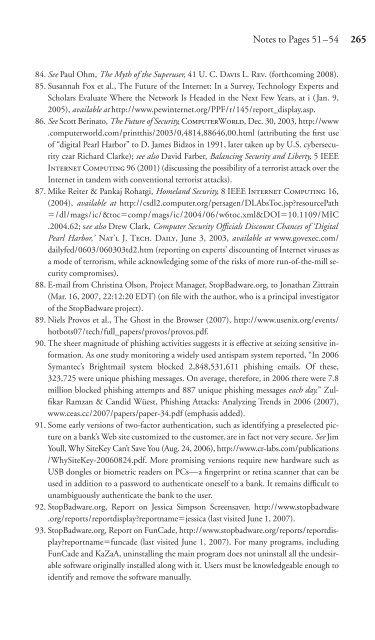Download - Future of the Internet â And how to stop it.
Download - Future of the Internet â And how to stop it.
Download - Future of the Internet â And how to stop it.
Create successful ePaper yourself
Turn your PDF publications into a flip-book with our unique Google optimized e-Paper software.
Notes <strong>to</strong> Pages 51–54 265<br />
84. See Paul Ohm, The Myth <strong>of</strong> <strong>the</strong> Superuser, 41 U. C. DAVIS L. REV. (forthcoming 2008).<br />
85. Susannah Fox et al., The <strong>Future</strong> <strong>of</strong> <strong>the</strong> <strong>Internet</strong>: In a Survey, Technology Experts and<br />
Scholars Evaluate Where <strong>the</strong> Network Is Headed in <strong>the</strong> Next Few Years, at i (Jan. 9,<br />
2005), available at http://www.pewinternet.org/PPF/r/145/report_display.asp.<br />
86. See Scott Berina<strong>to</strong>, The <strong>Future</strong> <strong>of</strong> Secur<strong>it</strong>y, COMPUTERWORLD, Dec. 30, 2003, http://www<br />
.computerworld.com/printthis/2003/0,4814,88646,00.html (attributing <strong>the</strong> first use<br />
<strong>of</strong> “dig<strong>it</strong>al Pearl Harbor” <strong>to</strong> D. James Bidzos in 1991, later taken up by U.S. cybersecur<strong>it</strong>y<br />
czar Richard Clarke); see also David Farber, Balancing Secur<strong>it</strong>y and Liberty, 5 IEEE<br />
INTERNET COMPUTING 96 (2001) (discussing <strong>the</strong> possibil<strong>it</strong>y <strong>of</strong> a terrorist attack over <strong>the</strong><br />
<strong>Internet</strong> in tandem w<strong>it</strong>h conventional terrorist attacks).<br />
87. Mike Re<strong>it</strong>er & Pankaj Rohatgi, Homeland Secur<strong>it</strong>y, 8 IEEE INTERNET COMPUTING 16,<br />
(2004), available at http://csdl2.computer.org/persagen/DLAbsToc.jspresourcePath<br />
/dl/mags/ic/&<strong>to</strong>ccomp/mags/ic/2004/06/w6<strong>to</strong>c.xml&DOI10.1109/MIC<br />
.2004.62; see also Drew Clark, Computer Secur<strong>it</strong>y Officials Discount Chances <strong>of</strong> ‘Dig<strong>it</strong>al<br />
Pearl Harbor,’ NAT’L J. TECH. DAILY, June 3, 2003, available at www.govexec.com/<br />
dailyfed/0603/060303td2.htm (reporting on experts’ discounting <strong>of</strong> <strong>Internet</strong> viruses as<br />
a mode <strong>of</strong> terrorism, while acknowledging some <strong>of</strong> <strong>the</strong> risks <strong>of</strong> more run-<strong>of</strong>-<strong>the</strong>-mill secur<strong>it</strong>y<br />
compromises).<br />
88. E-mail from Christina Olson, Project Manager, S<strong>to</strong>pBadware.org, <strong>to</strong> Jonathan Z<strong>it</strong>train<br />
(Mar. 16, 2007, 22:12:20 EDT) (on file w<strong>it</strong>h <strong>the</strong> author, who is a principal investiga<strong>to</strong>r<br />
<strong>of</strong> <strong>the</strong> S<strong>to</strong>pBadware project).<br />
89. Niels Provos et al., The Ghost in <strong>the</strong> Browser (2007), http://www.usenix.org/events/<br />
hotbots07/tech/full_papers/provos/provos.pdf.<br />
90. The sheer magn<strong>it</strong>ude <strong>of</strong> phishing activ<strong>it</strong>ies suggests <strong>it</strong> is effective at seizing sens<strong>it</strong>ive information.<br />
As one study moni<strong>to</strong>ring a widely used antispam system reported, “In 2006<br />
Symantec’s Brightmail system blocked 2,848,531,611 phishing emails. Of <strong>the</strong>se,<br />
323,725 were unique phishing messages. On average, <strong>the</strong>refore, in 2006 <strong>the</strong>re were 7.8<br />
million blocked phishing attempts and 887 unique phishing messages each day.” Zulfikar<br />
Ramzan & Candid Wüest, Phishing Attacks: Analyzing Trends in 2006 (2007),<br />
www.ceas.cc/2007/papers/paper-34.pdf (emphasis added).<br />
91. Some early versions <strong>of</strong> two-fac<strong>to</strong>r au<strong>the</strong>ntication, such as identifying a preselected picture<br />
on a bank’s Web s<strong>it</strong>e cus<strong>to</strong>mized <strong>to</strong> <strong>the</strong> cus<strong>to</strong>mer, are in fact not very secure. See Jim<br />
Youll, Why S<strong>it</strong>eKey Can’t Save You (Aug. 24, 2006), http://www.cr-labs.com/publications<br />
/WhyS<strong>it</strong>eKey-20060824.pdf. More promising versions require new hardware such as<br />
USB dongles or biometric readers on PCs—a fingerprint or retina scanner that can be<br />
used in add<strong>it</strong>ion <strong>to</strong> a password <strong>to</strong> au<strong>the</strong>nticate oneself <strong>to</strong> a bank. It remains difficult <strong>to</strong><br />
unambiguously au<strong>the</strong>nticate <strong>the</strong> bank <strong>to</strong> <strong>the</strong> user.<br />
92. S<strong>to</strong>pBadware.org, Report on Jessica Simpson Screensaver, http://www.s<strong>to</strong>pbadware<br />
.org/reports/reportdisplayreportnamejessica (last vis<strong>it</strong>ed June 1, 2007).<br />
93. S<strong>to</strong>pBadware.org, Report on FunCade, http://www.s<strong>to</strong>pbadware.org/reports/reportdisplayreportnamefuncade<br />
(last vis<strong>it</strong>ed June 1, 2007). For many programs, including<br />
FunCade and KaZaA, uninstalling <strong>the</strong> main program does not uninstall all <strong>the</strong> undesirable<br />
s<strong>of</strong>tware originally installed along w<strong>it</strong>h <strong>it</strong>. Users must be knowledgeable enough <strong>to</strong><br />
identify and remove <strong>the</strong> s<strong>of</strong>tware manually.


